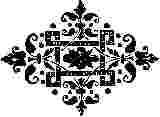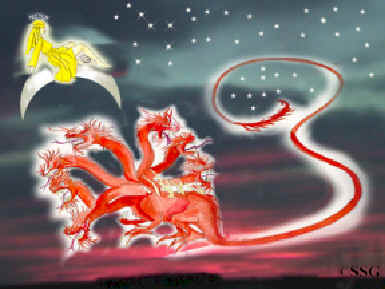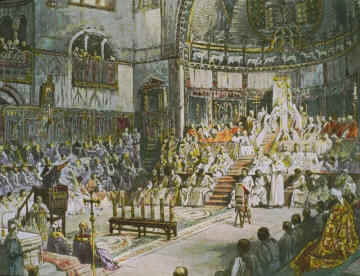Part II
Verse
3
"And there appeared another wonder in heaven; and behold a
great red dragon, having seven heads and ten horns, and seven crowns upon his heads." |
The "heaven" referred to cannot be God’s true
heaven. Jesus in his pre-human existence said, "I beheld Satan as lightning fall from
heaven." (Luke 10:18)
Satan has not been in God’s heaven since, nor will he ever be
there again. In Job 1:7 we read of his confinement: "Satan answered the LORD, and
said, From going to and fro in the earth...."
Normally, we would expect the "dragon" to operate on the
earth as civil authority is supposed to. However, in this vision the "dragon"
appears in "heaven" or in the powers of spiritual control.
Notice it does not have wings, but is endowed with "seven
heads" and "ten horns." We understand the "seven heads" to be
successive, that is, one "head" would control the "dragon" and then
another and so on.
These "seven heads" each wear a "crown," a
"crown" for each "head." The "crown" would indicate
authority to rule, or kingly authority. The "ten horns" or territorial divisions
of the Roman Empire are not crowned. They are under the headship of each emperor or
"head."
SYMBOL |
REPRESENTS |
|
7 Heads |
7 Successive Rulers |
|
10 Horns |
10 Territorial Divisions of
Roman Empire |
|
Crown on Each
Head |
Authority of King or Emperor to
Rule over the 10 Territorial Divisions of Empire |
The "dragon" is shown with centralized authority throughout
the successive reign of the "seven heads." We know who the power behind the
successive thrones really was. We are not even left to guess. We are told it was
"that old serpent, called the Devil, and Satan."
(Revelation 12:9)
We normally would expect the "dragon" to rule the earth in
civil matters. The Roman Empire was to be the last dominion before God’s kingdom.
This "dragon" is not satisfied to just rule the earth, but wished to rule both
the "heavens" (spiritual ruling authority) and the "earth" (civil
ruling authority). If the "dragon" could rule both "heaven" and
"earth" from one seat, it would please him well.
However, as our story unfolds, the "dragon" loses this
convenient control from one central authority, and must shuttle back and forth from civil
rulership to religious rulership. This was not convenient for the "dragon" and
certainly not his first choice.

Verse
4
"And his tail drew the third part of the stars of
heaven, and did cast them to the earth: and the dragon stood before the woman which was
ready to be delivered, for to devour her child as soon as it was born." |
|
In Isaiah 9:15 we are told: "The prophet that teacheth lies is the tail."
The "dragon" was already in "heaven," or the
spiritual realm, when its "tail drew the third part of the stars of heaven" to
cast them "to the earth."
The lying "tail" needed to rid itself of the faithful to
retain an appearance of unity.
|

Revelation 12:4 |
When Constantine entered the church it was not as a penitent seeking
God’s grace. He entered as the "Pontifex Maximus," Chief Religious Ruler.
The faithful bishops were divested of authority when they did not consent to what
Constantine ultimately decided was correct or usable for the empire. Truth was not the
criteria.
What Constantine wanted was a united front for his new found state
religion. He had plenty of division and divisiveness under the pagan rule with three
thousand gods.
He wanted a united front to parade before the nation and was ready to
cast out from religious authority all that would not bow the knee to his decisions. Hence
bishops such as Arius and his associates were put down and lost voice in the spiritual
heavens as they were "cast" to "the earth."
Who is the "third part"? We are schooled in fractions and in our
schooling one-third denotes a proportional part of a whole. Scripture does not fit into
that mold. In Zechariah 13:8, 9 we read:
"And it shall come to pass, that in all the land, saith the Lord, two
parts therein shall be cut off and die; but the third shall be left therein.
"And I will bring the third part through the fire, and will refine them as
silver is refined, and will try them as gold is tried: they shall call on my name, and I
will hear them: I will say, It is my people."
We may gather from this that the "third part" is the
faithful part, the right-hearted, of whom God may say, "It is my people." It has
no meaning of proportion or mathematical value. The part that God is pleased with is the
"third part."

The Council of Nicea in 325 A.D.
The "dragon," the civil authority of
Rome, embodied in Constantine in that time, "stood before the
woman."
Constantine invited all the "bishops" of the various
Christian Churches to Nice.
He wished to enlist or appropriate under his leadership all those
leaders who would be subordinate to his authority.
|
The "dragon" planned to control both the religious and civil
authority from one imperial seat. That was his first choice. When someone is looking to
control, they seek subordination in those under them.
Constantine "cast out" from the spiritual ruling
"heavens" those who would not compromise biblical truth for political favor.
It is not that Constantine did not highly regard some of those he ostracized. However, he
needed consensus, unity and subordination of all those under his spiritual control. He
often went out of his way to bring stubborn adherents to truth under his banner.
Failing in this, they were inevitably "cast to the earth."
Truth defenders may have lost their standing in the powers of spiritual control, but we
know you can do nothing against the truth. It is of God and, therefore, "the eternal
ages are its years." It will prevail, because God’s Word cannot be broken.
Why did the "dragon" stand "before the
woman?"
Constantine wanted to subordinate the leaders of the church at the time
the bishops emerged as a ruling class. He could thereby rule both the "heaven"
(spiritual ruling power) and the "earth" (the civil ruling power) under one
scepter.
If he could succeed in this he would have maximum efficiency. Failing
in this, the devil would have to revert to a second choice of wearing two hats to cover
two thrones, which, in fact, he finally did. In Revelation 2:13 it is said of Christians:
"Thou dwellest, even where Satan’s seat is."

Verse
5
"And she brought forth a man
child, who was to rule all
nations with a rod of iron: and her child was caught up
unto God, and to his throne." |
This is not a literal "man-child" just as this is
not a literal "woman" or a literal "dragon."
This "man-child" could not be Jesus, as he was the forerunner
of the church and not its child.
If the "woman" is alleged to be the "Sarah
Covenant" that brought forth Jesus, the "man-child," we are faced with
another problem. Jesus was not caught up to heaven as a child. The child Jesus with his
parents had to flee to Egypt. There was no throne for Jesus here on earth.
The "dragon," represented in Pilate, succeeded in putting
Jesus to death when he was thirty-three years old. Jesus never referred to himself as a
"man-child." He often referred to himself as the "Son of man."
Additionally, Sarah had only one child, Isaac.
When Pharaoh and Abimelech wanted to take Sarah to wife, God moved
mightily and with dispatch, plaguing "Pharaoh" and threatening Abimelech with
death. (Genesis 12:17; 20:3) Sarah was the mother of only one child, Isaac. This
"woman" has remnant of "seed" subsequently.
(Revelation 12:17)
The "man-child" was not Jesus, but it was the
"man of sin" child that emerged from within the early church. Those looking for
a "man of sin" at the end of the age, are overlooking the real "man of
sin" born early on.
The "dragon" stood before the "woman" (the
Christian Church) to appropriate her child. Constantine invited the powerful bishops to
Nice to bring the bishops under his sovereign control. He gave them generous gifts and had
a banquet for them at the end of their sessions. He wanted to walk away with this
"man-child" in his pocket. Momentarily, this was so.
However, at Constantine’s death his son Constantius succeeded him
for a short time and died. Julian, a very noble pagan, then took the throne and intensely
disliked the bishops. Julian did not wish to work with them.
Here the "dragon" momentarily lost interest in this perverse
"man-child." This pause by the Emperor Julian enabled the man-child to be
"caught up unto God, and to his throne."
With the death of Constantine and his son Constantius, the man-child
lost its chief religious ruler—the Pontifex Maximus. This was Papacy's moment of fortune.
They appointed their own Pontifex Maximus, first as the fancied bishop of bishops and
finally as the pope. The "man-child" is described in 2 Thessalonians 2:4 in
these words:
"Who opposeth and exalteth himself above all that is called God, or that
is worshipped; so that he as God sitteth in the temple of God, shewing himself that he is
God."
The man-child was "caught up
unto God and to his throne" in
apostasy as the "man of sin" or the "son of perdition," having its own
earthly head. The headship of Christ was rejected and also the headship of the Roman
emperor. It would have its own religious Pontifex Maximus, the bishop of bishops or the
pope.

Verse
6
"And the woman fled into the wilderness, where she hath a
place prepared of God, that they should feed her there a thousand two hundred and
threescore days." |
We leave the story of the "man child" momentarily to focus on
the poor "woman’s" plight after being delivered of this unwanted and
unloved "child." She "fled into the wilderness" (of separation) where
God would provide for her.
|
Oddly enough, this parallels
Elijah’s three and one-half years (1260 days) in the wilderness
during the great draught.
This "woman" was fed similarly
"for a thousand two hundred and threescore days" (1260 days—each
day representing a year).
|

Elijah at Brook Cherith
|
Please notice the time setting here. While the
"man child" is caught up to glory in this time frame, the "woman"
languishes through the famine and survives only by the grace and power of God to sustain
her. Clearly, the papal exaltation and glory from CE 539 to 1799 is in stark contrast to
the "faithful Church’s" wilderness experience in harsh and difficult
conditions, kept by the power of God.
The time given us in this verse is easily identified and becomes
critical to understanding this verse.
Why the difference in gender between "Elijah" and the
"woman?" This difference is easy to explain.
"Elijah" is God’s mouthpiece before
nominal spiritual Israel. Hence the masculine gender is appropriate. The "woman"
pictures the faithful "church" as persecuted and marked for destruction.
True to Bible symbolism, a "woman" represents a
"Church." She survives only by the grace of God. If this "man child"
were the true Christ, why would the "Church" be in such dire straits? When
Christ’s true mediatorial reign on earth takes place his true followers will be with
him in glory, certainly not in the wilderness condition.